The What, Where, Why, and How of effectively Defining and Tracking your Sales (and Purchases)
| • | Sale-Purchase Items are the codes and descriptions (and usually prices) for what your business sells and buys. |
| • | Parts, Recurring Revenues, Labor, Trip Charges, General Expenses, Interest, Late Fees, Shipping Charges, etc. are all transactions that must be categorized, sold or bought, and later reported as such. |
| □ | Why are they so important? |
| • | Your business must have accurate reports of Sales, Services, Purchases, and other Expenses to know where your revenue comes from and how (and why) it is being spent. |
| • | Proper reporting first requires proper filing (categorization) of these financial transactions. |
| • | Because all of these Sales, Services, Purchases, and other Expenses are coded, as these transactions are entered, they are filed by code, quantity and amount - and so may be reported that way, as well. |
.
| □ | What are Sale-Purchase Item Codes used for? |
| □ | Which module(s) need Sale-Purchase Item Codes? |
| • | Accounts Receivable to accurately record each itemized sale and optionally to track and report Commissions earned on those sales. |
| • | To define these Sale-Purchase Items, from the Main Menu Select the Maintenance Menu and Choose Sales-Purchase Items. |
| • | See the "Adding Sale-Purchase Items" section below for complete information. |
| 1. | General Sales & Purchases - (See "Sales / Purchases / Both" below) - Defines a generic part or labor charge, a lump sum installation fee, trip charge, or any other type of sale such as a Late Fee |
| 4. | Service Department related Sales (for flat rate and non-itemized sales like Hours or Trip Charges) |
| □ | Sales / Purchases / Both - These Sale-Purchase Items may be used for Invoicing Sales to Subscribers, entering Purchases from Vendors, or used for defining Both Sales and Purchases (things you "both" Buy and Sell - like system parts). |
| • | When entering a Proposal you will use these Sale-Purchase Items to "itemize" that Proposal. |
| • | When manually entering Sales Invoices, or automatically Billing your Recurring Revenue, these Sale-Purchase Items will be used to Itemize those Invoices for those Subscriber(s). |
| • | When entering Bills from your Vendors, these Sale-Purchase Items will be used to identify each type of item that was purchased. |
| □ | Adding Sale-Purchase Items - For Installations, Late Fees, Shipping Charges, and Service Sales, Labor, etc. (also see Purchase Categories). |
| • | To create a Sale-Purchase Item that defines things like a part or labor charge, a lump sum installation fee, trip charge, or any other type of Sale such as a Late Fee that would be billeed to a Subscriber, from the Main Menu Select the Maintenance Menu and Choose Sales-Purchase Items. |
| ► | Note: A generic Sale-Purchase Item named Finance/Late Charges assigned the Item ID code F/C is included in the system when initially installed. |
Do not delete this F/C code!
If not present, be sure to create a generic Sale-Purchase Item named Finance/Late Charges assigning it the Item ID code F/C as shown below.
(For General Ledger System Users: Sale GL # and Purchase GL # should be entered based on your General Ledger Accounts).
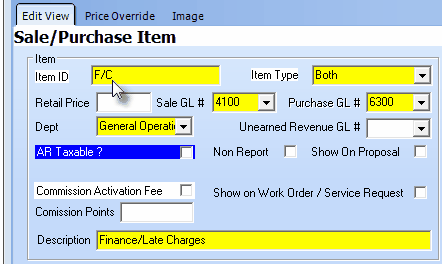
Sale/Purchase Item Form - Edit View tab - Finance Charge
| • | As with all Data Entry Forms within MKMS, a Yellow field indicates that this is a mandatory field which must be completed before the record can be saved. |
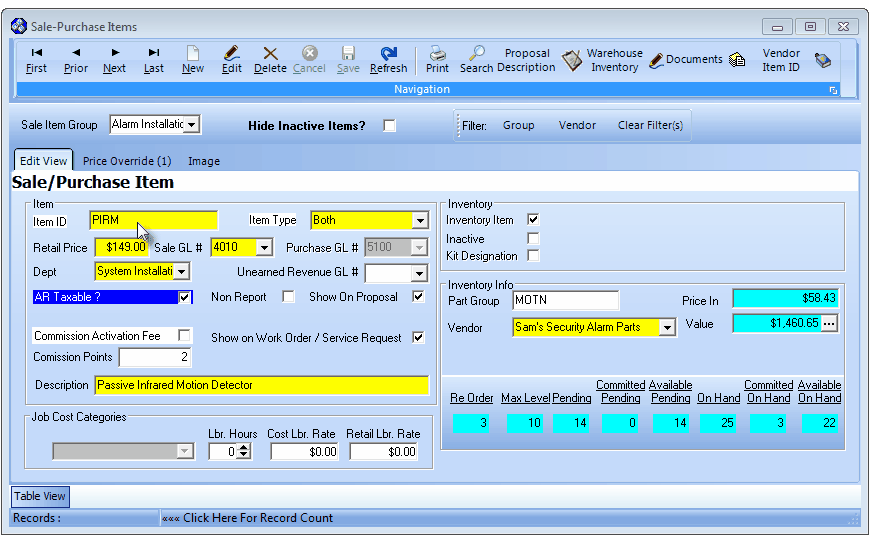
Sale/Purchase Item Form - Average Inventory Cost method is in effect
| • | This Sale-Purchase Items Form may be Re-sized by Dragging the Top and/or Bottom up or down, and/or the Right side in or out. |
| • | Navigation Menu - The Navigation Menu is located at the top of the Sale-Purchase Items Form. |

| • | This Navigation Menu provides the normal Record Movement, New, Edit, Delete, Cancel, Save, and Refresh options; as well as Print, Search, Proposal Description, Warehouse Inventory, Documents and Vendor Item ID functions. |
| ▪ | Print - Click the Print Icon to view and/or print a list of all defined Sale-Purchase Items. |
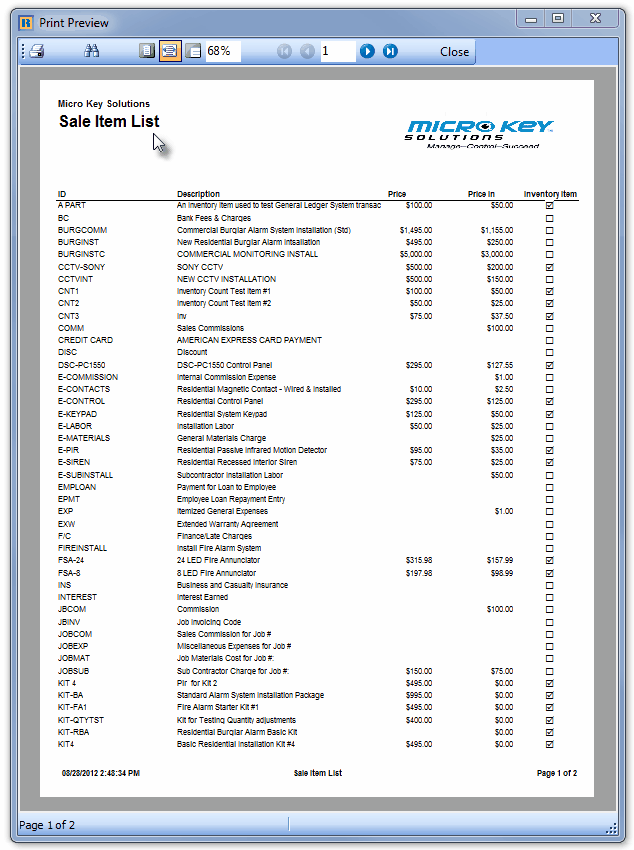
Sale-Purchase Item Form - Printed Sale Item List
| ▪ | Search - Click the Search Icon to located a previously entered defined Sale-Purchase Item. |
| ▪ | Proposal Description - Click the Proposal Description Icon to open the Proposal Description editor (see "Proposal Description" below). |
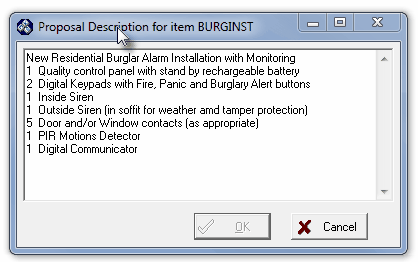
Proposal Description editor
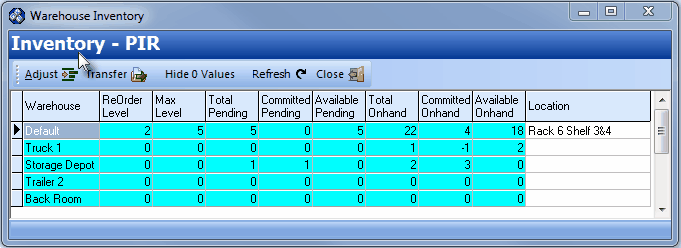
Warehouse Inventory Form
| ▪ | Documents - Click the Documents Icon to open the Documents for dialog from where files (and file links) related to this Sale-Purchase Item may be identified. |
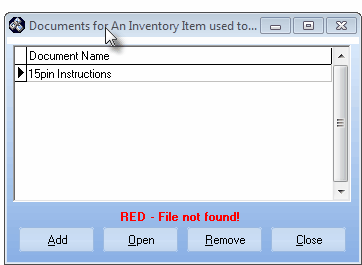
Documents for... Form
| ▪ | Vendor Item ID - Click the Vendor Item ID Icon to open the Vendor ID Form in which the specific Part Numbers used by various Vendors may be defined. |
| • | Record Editing section - The details of the currently selected record are displayed within the Edit View tab below the Navigation Menu at the center (Main Body) of the Sale-Purchase Items Form. |
| • | Table View tab - A tabular (spreadsheet style) Table View of the currently defined Sale-Purchase Items is accessible by Clicking the Table View tab at the bottom of the Sale-Purchase Items Form. |

| • | To display a specific Sale-Purchase Item record within the Edit View tab in the Record Editing section, Click on that record within the Table View section, or use the Search Icon. |
| • | This Table View information may be Pinned in Place by Clicking the Pin Icon on the right. |

Sale-Purchase Items Form - with Table View tab Pinned Open
| ▪ | You may Un-Pin this Table View by Clicking the Pin Icon again. |
| ▪ | Click on any listed record to display that information in the center (Main Body) of the Form. |
| • | Each data column's Header Name describes the data contained in that column. |
| ▪ | Clicking on a Header Name will set the order in which the (Sale-Purchase Items) data will be listed. |
| ▪ | Clicking on the same Header Name will set the order in the opposite direction (ascending vs. descending). |

| ▪ | The Header Name that is determining the Order of the (Sale-Purchase Items) data, will have an Icon - indicating the Order in which it is displayed - to the right of that Header Name. |

| ▪ | Use the Slide Bar at the bottom of the Sale-Purchase Items list to see the data listed in all of the columns. |
| • | There are eight columns of data in this Sale-Purchase Items listing: |
| 1) | Sale Item ID - The Code representing this Sale-Purchase Item. |
| 2) | Description - The Description of this Sale-Purchase Item. |
| 3) | Item Type - B = Both; S = Sale; P = Purchase |
| 4) | Price - The Retail Price for this Sale-Purchase Item. |
| 5) | Part - If this Sale-Purchase Item entry represents an Inventory Item it will be True ("T"), otherwise it will be False ("F"). |
| 6) | Price In - This is the Wholesale (Cost) of this Sale-Purchase Item. |
| 7) | AP ID - This is the record number of the Vendor from whom this Sale-Purchase Item is generally purchased. |
| 8) | SA Account - For General Ledger System Users: this is the General Ledger Sales Account - if assigned to this Sale-Purchase Item entry. |
| • | To define Sale-Purchase Items, Click the  Icon on the Navigation Menu to start the entry. Icon on the Navigation Menu to start the entry. |

| • | Sale Item Group - Optionally, you may enter a Sale Item Group using the Drop-Down Selection List provided. |
| ▪ | If you have a large quantity of Sale-Purchase Items, this Sale Item Grouping feature allows you to Select the desired Sale-Purchase Item from a filtered list (based on the Sale Item Group assigned to it). |
| ▪ | The Advanced Sale Item Lookup function (accessed with Alt+F2 from within the Sale-Purchase Item Drop-Down Selection List on Sales, Proposal, Purchase Order and Purchases forms) lets you Select from a list of items limited to a specific group - thereby presenting a much shorter list from which to choose. |
| • | Item ID - Enter a unique code of up to 40 alpha-numeric characters with most punctuation marks permitted. |
| ▪ | All letters will be capitalized automatically. |
| • | Item Type - This item is either a Sale, a Purchase or Both which indicates this item (Part or Service) could be bought and sold and so would be used for Both cases (see Sale / Purchase / Both above). |
| o | Add the actual Part Number (Vendor ID) used by each of the Vendors from whom you make this purchase. |
| ▪ | This Vendor Item ID will not appear if Sale was assigned as the Item Type. |
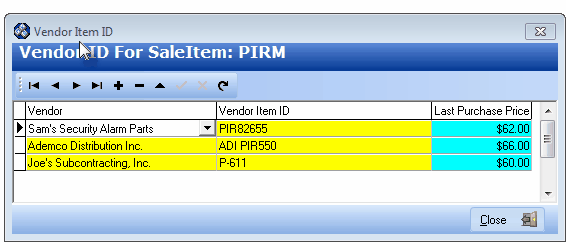
Vendor Item ID entry
| • | Retail Price - Enter the usual Retail Price for this item (suggested, but not mandatory unless this is an item that will be part of your Inventory and you're using the Inventory Tracking & Job Costing System, in which case the Retail Price is mandatory. |
| ◆ | If you are using the General Ledger System, these fields will be highlighted in Yellow indicating a mandatory entry. |
| o | Purchase GL # - If this Sale-Purchase Item is assigned an Item Type of Purchase, or represents Both a Sale and a Purchase item, both the Sale GL # and the Purchase GL # must be entered using the Drop-Down Selection List provided. |
| o | Dept - If using the multiple Departments feature,use the Drop-Down Selection List provided to Choose the appropriate Department. |
| ◆ | If you have implemented multi-departmental accounting, this field is Mandatory. |
| • | Check boxes - There are several Check Boxes that may, or may not be needed based on the specific Purpose of this Sale-Purchase Item: |
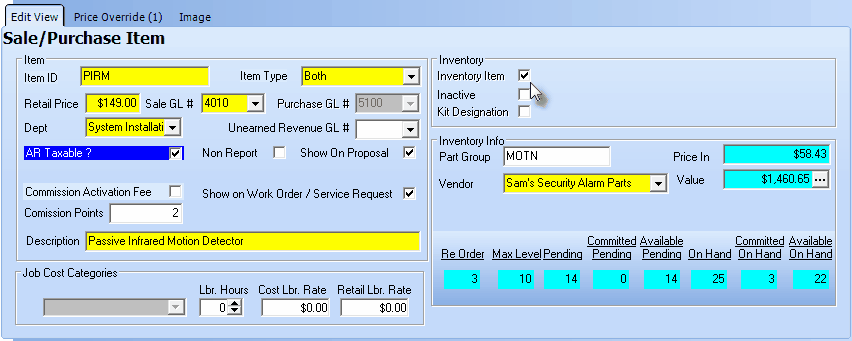
| ▪ | Show on Work Order / Service Request - Check the Show on Work Order / Service Request box if this Sale-Purchase Item has been assigned an Item Type of Sale or Both and might be needed when recording the use of Inventory and/or Materials on a Service Request. |
| o | The Drop-Down Selection List used to Choose the appropriate Inventory and/or Materials usage in the Inventory/Materials tab of the Service Request Form will now contain only those Sale-Purchase Items which have a Check in the Show on Work Order / Service Request box. |
| o | By Not Checking this box, this Sale-Purchase Item will not be included in the Drop-Down Selection List lists that are provided to a Technician working in the field using the Web Tech Service or to any User recording information within the Inventory and/or Materials tab on a Service Request Form. |
| o | The result is that any Sale-Purchase Items that are defined to identify Purchases or Sales that are unrelated to providing Service to Subscribers will be eliminated from the list - making that Selection process easier and faster, thus reducing the Drop-Down Selection List list to a manageable size, and more importantly, with a definable content. |
| ▪ | Show on Proposal - Check the Show on Proposal box if this is a Sale item which may be used on a Proposal (also see Proposal Description below). |
| ▪ | Inactive - Located within the Inventory section of the Sale-Purchase Item Form, this Check box identifies an item as Inactive and therefore no longer in use. |
| o | The Inactive Check box is provided because, once entered and used, a Sale-Purchase Item cannot be deleted because it has become part of the Transaction "History" of the system. |
| o | Checking this box will remove this item from the Drop-Down Selection Listes normally used to Choose a specific Sale-Purchase Item for a Sale or Purchase. |
| • | Description - Enter a clear, concise description of this Sale-Purchase Item. |
| ▪ | You may enter up to 70 alpha-numeric characters, upper and lower case letters are allowed, most punctuation marks, with spaces permitted, also. |
| ▪ | For Sale-Purchase Items defined with an Item Type of either Both or Sale, you may enter a more detailed Description using the Proposal Description Icon at the top of the Form (also see Proposal Description below). |
| • | Proposal Description - Click the Proposal Description on the Navigation Menu at the top of the Sale-Purchase Items Form to create a longer and more detailed description of this Sale-Purchase Item. |

| ▪ | This expanded description will be shown on Proposals containing this Sale-Purchase Item. |
| ▪ | Type whatever is appropriate. |
| ▪ | Click ü OK to save the entry. |
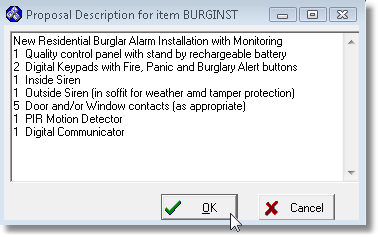
Proposal Description for Sale-Purchase Item
| • | Price In - Enter the Price In (the actual cost or wholesale value) for this item. |
| ▪ | This is particularly important if the Sale-Purchase Item is to be used to identify Both a Purchase and a Sale, or if you will be using the Pricing Mark Up Groups to a calculate the Retail Price for this item on an Invoice or a Proposal. |
| o | If this is an Inventory Item, the Price In field becomes a mandatory entry. |
| ▪ | If Average Inventory Costing is selected as the Inventory Valuation Method, the system maintained Price In field is the Average Price Paid for this Inventory Item, and the system maintained total Value field is computed by multiplying that Price In Amount by the On Hand Quantity. |
| • | Sale Item Group - Optionally, you may also enter a Sale Item Group using the Drop-Down Selection List provided. |
| ▪ | If you have a large quantity of Sale-Purchase Items, this Sale Item Grouping feature allows you to Select the desired Sale-Purchase Item from a filtered list (based on the Sale Item Group assigned to it). |
| ▪ | The Advanced Sale Item Lookup function (accessed with Alt+F2 from within the Sale-Purchase Item Drop-Down Selection List on Sales, Proposal, Purchase Order and Purchases forms) lets you Select from a list of items limited to a specific group - thereby presenting a much shorter list from which to choose. |
| • | AR Taxable? - Check this box if this Sale-Purchase Item is normally Taxable when making a Sale. |

| ▪ | When entering a Sales Invoice: |
| a) | If AR Taxable? is Checked, whenever this Sale-Purchase Item is entered on a Sales Invoice, the appropriate Tax Code & Tax Percentage Rate will be inserted automatically, based on the Sales Tax information entered in the Accounting Info Tab for that Subscriber. |
| b) | If Not Checked, whenever this Sale-Purchase Item is entered on a Sales Invoice, the Tax Code will be entered as N (Non) and the Tax Percentage Rate set set at 0%, regardless of the Sales Tax information entered in the Accounting Info Tab for that Subscriber. |
| • | AP Taxable? - Under Development - If present, Check this box if this Sale-Purchase Item is normally Taxable when making a Purchase. |

| ▪ | When entering a Bill (Purchase Invoice) Under Development: |
| a) | If AP Taxable? is Checked, whenever this Sale-Purchase Item is entered for a Bill (Purchase Invoice), the appropriate Tax Code will be inserted, and the Tax Percentage Rate will be used to calculate the Sales Tax Amount based on the Sales Tax information entered in the Vendor Tax Information tab for that Vendor. |
| b) | If Not Checked, whenever this Sale-Purchase Item is entered for a Bill (Purchase Invoice), the Tax Code will be entered as No and the Tax Amount set at 0%, regardless of the Sales Tax information entered in the Vendor Tax Information tab for that Vendor. |
| • | Commission Activation Fee - Check this Box if this Sale-Purchase Item is to be considered an Activation Fee when it is included as part of a Proposal Package used in conjunction with the Commission Tracking System. |
| • | Commission Points - Enter a Point Value (representing its approximate cost) if this Sale-Purchase Item earns Commissions Points for the Salesperson when it is sold. |
| ▪ | The Commission Points assigned to a Sale-Purchase Item should represent an approximate Cost for the acquisition and installation of the component. |
| ▪ | Commission Points are assigned a Point Value - on an Employee by Employee basis - in the Personal tab of the Employee Form. |
| • | Click the Save (<) Icon to record this entry. |
| ► | Important Note: Also see the following chapters which explain these two special purpose Sale-Purchase Items. |
| □ | Sale-Purchase Items Form tabs: |
| • | There are three tabs on the Sale-Purchase Items Form: |

| 1. | Edit View - As shown in the illustration below, the Edit View tab is used for the actual data entry of the Sale-Purchase Items. |

Sale Purchase Items Form with the Edit View data entry tab displayed
| 2. | Price Override - As shown in the illustration below, the Price Override tab is used to enter a different set of Pricing Mark Up/Down Percentages for previously defined Pricing Mark Up Groups, as appropriate. |
| ▪ | The Price Overrides tab will display the number of entries within the tab. |
| o | If the User answers Yes, the Price Override value will be applied. |
| ▪ | To define a Price Override: |
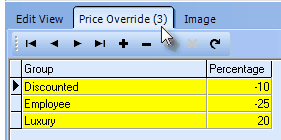
Price Overrides tab on Sale Purchase Items Form
| b. | Group - Using the Drop-Down Selection List provided, Choose one of the previously defined Pricing Mark Up Groups. |
| c. | Percentage - Enter the Override Mark Up/Down Percentage Rate - as a positive or negative value - indicating that the regular Retail Price entered for this Sale-Purchase Item should be increased or decreased respectively, as described in the Pricing Mark Up Groups chapter. |
| d. | Save - Click the Save ("ü") button to record this Price Override. |
| 3. | Image - As shown in the illustration below, the Image tab is used to enter a picture of the Sale-Purchase Item, when appropriate. |
| ▪ | By using this Image tab to identify an Inventory Item or Kit, it provides the User access to an actual picture of that Part. |
| ▪ | Images attached to a Sale-Purchase Item record my also be included on a printed Proposal based on the options selected when Printing a Proposal. |

Sale Purchase Items - Image tab
| a. | Choose - Click the Choose button and, using the standard Windows® dialogue box provided, locate the desired file. |
| o | This should be a BMP or JPG file approximately 5 x 5 inches at 72 ppi. |
| b. | Image Adjustment - Once the Sale-Purchase Item's BMP or JPG file is selected, Choose the Image Adjustment method that best displays your Sale Purchase Item in the display box by alternately Clicking Show Image At Actual Size and Stretch Image To Fit. |
| □ | Sale Item Group field, the Hide Inactive Items box, and two Filter Buttons: |
| • | Sale Item Group - Optionally, you may also enter a Sale Item Group using the Drop-Down Selection List provided. |
| • | If you have a large quantity of Sale-Purchase Items, this Sale Item Grouping feature allows you to Select the desired Sale-Purchase Item from a filtered list (based on the Sale Item Group assigned to it). |
| • | The Advanced Sale Item Lookup function (accessed with Alt+F2 from within the Sale-Purchase Item Drop-Down Selection List on Sales, Proposal, Purchase Order and Purchases forms) lets you Select from a list of items limited to a specific group - thereby presenting a much shorter list from which to choose. |
| • | Hide Inactive Items? - Check this box to exclude from the Form, those Sale-Purchase Items which have been Identified as Inactive. |

Group and Vendor Filter buttons on the Sale Purchase Items Form
| • | These Filter buttons may be used individually, or together, to limit which Sale-Purchase Items are available for review. |
| □ | For Accounts Payable System users, there are just three general types of Sales-Purchase Items that you will need to define so that you can record the Expense Transactions in the Accounts Payable System. |
| 1. | Recurring Purchases - similar in concept to billing Recurring Revenue except that it represents fixed fee Invoices you get regularly such as your Rent, Mortgage, Truck and other Loan Payments. |
| 2. | Inventory items (usually Parts - and so they are often used as both Sale and Purchase items). |
| • | These are entered in the same manner as above but generally assigned an Item Type code of Purchase or Both. |
| • | Both - The Sale-Purchase Items that represent things you both Buy and Sell (such as the system parts purchased for resale). |
| ► | Note: If you are not currently using the General Ledger module and do not plan on doing so in the future, you may skip the GL # fields. |
| • | If Sale-Purchase Item is assigned an Item Type of Sale, assign only a Sale GL # using the Drop-Down Selection List provided. |
| • | If Sale-Purchase Item is assigned an Item Type of Purchase, assign only a Purchase GL # using the Drop-Down Selection List provided. |
| • | If Sale-Purchase Item is assigned an Item Type of Both (because it is used as a Sale and a Purchase item), the Sale GL # and the Purchase GL # must be entered using the Drop-Down Selection List provided. |















![]()

![]()
![]()
![]()


![]()

![]()

![]()



